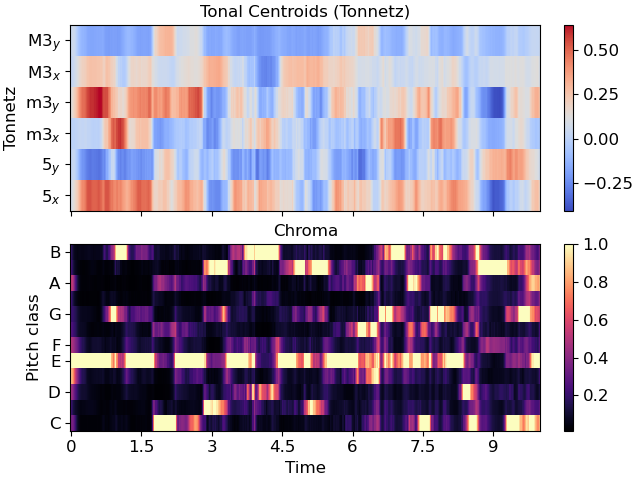Caution
You're reading the documentation for a development version. For the latest released version, please have a look at 0.11.0.
librosa.feature.tonnetz
- librosa.feature.tonnetz(*, y=None, sr=22050, chroma=None, **kwargs)[source]
Compute the tonal centroid features (tonnetz)
This representation uses the method of [1] to project chroma features onto a 6-dimensional basis representing the perfect fifth, minor third, and major third each as two-dimensional coordinates.
- Parameters:
- ynp.ndarray [shape=(…, n,)] or None
Audio time series. Multi-channel is supported.
- srnumber > 0 [scalar]
sampling rate of
y- chromanp.ndarray [shape=(n_chroma, t)] or None
Normalized energy for each chroma bin at each frame. If None, a cqt chromagram is performed.
- **kwargsAdditional keyword arguments to
chroma_cqt, if
chromais not pre-computed.- Cnp.ndarray [shape=(…, d, t)] [Optional]
a pre-computed constant-Q spectrogram
- hop_lengthint > 0
number of samples between successive chroma frames
- fminfloat > 0
minimum frequency to analyze in the CQT. Default: C1 ~= 32.7 Hz
- normint > 0, +-np.inf, or None
Column-wise normalization of the chromagram.
- thresholdfloat
Pre-normalization energy threshold. Values below the threshold are discarded, resulting in a sparse chromagram.
- tuningfloat [scalar] or None.
Deviation (in fractions of a CQT bin) from A440 tuning
- n_chromaint > 0
Number of chroma bins to produce
- n_octavesint > 0
Number of octaves to analyze above
fmin- windowNone or np.ndarray
Optional window parameter to filters.cq_to_chroma
- bins_per_octaveint > 0, optional
Number of bins per octave in the CQT. Must be an integer multiple of
n_chroma. Default: 36 (3 bins per semitone) If None, it will matchn_chroma.- cqt_mode[‘full’, ‘hybrid’]
Constant-Q transform mode
- Returns:
- tonnetznp.ndarray [shape(…, 6, t)]
Tonal centroid features for each frame.
- Tonnetz dimensions:
0: Fifth x-axis
1: Fifth y-axis
2: Minor x-axis
3: Minor y-axis
4: Major x-axis
5: Major y-axis
See also
chroma_cqtCompute a chromagram from a constant-Q transform.
chroma_stftCompute a chromagram from an STFT spectrogram or waveform.
Examples
Compute tonnetz features from the harmonic component of a song
>>> y, sr = librosa.load(librosa.ex('nutcracker'), duration=10, offset=10) >>> y = librosa.effects.harmonic(y) >>> tonnetz = librosa.feature.tonnetz(y=y, sr=sr) >>> tonnetz array([[ 0.007, -0.026, ..., 0.055, 0.056], [-0.01 , -0.009, ..., -0.012, -0.017], ..., [ 0.006, -0.021, ..., -0.012, -0.01 ], [-0.009, 0.031, ..., -0.05 , -0.037]])
Compare the tonnetz features to
chroma_cqt>>> import matplotlib.pyplot as plt >>> fig, ax = plt.subplots(nrows=2, sharex=True) >>> img1 = librosa.display.specshow(tonnetz, ... y_axis='tonnetz', x_axis='time', ax=ax[0]) >>> ax[0].set(title='Tonal Centroids (Tonnetz)') >>> ax[0].label_outer() >>> img2 = librosa.display.specshow(librosa.feature.chroma_cqt(y=y, sr=sr), ... y_axis='chroma', x_axis='time', ax=ax[1]) >>> ax[1].set(title='Chroma') >>> fig.colorbar(img1, ax=[ax[0]]) >>> fig.colorbar(img2, ax=[ax[1]])
